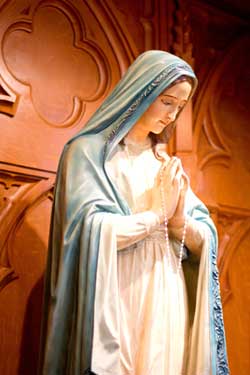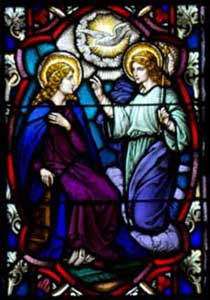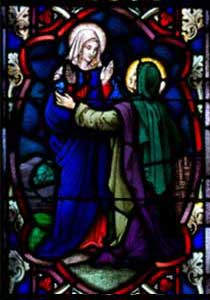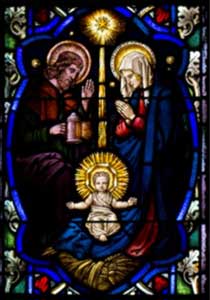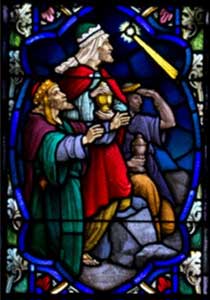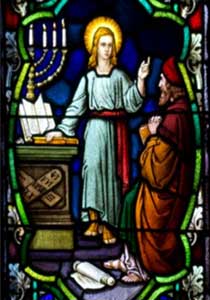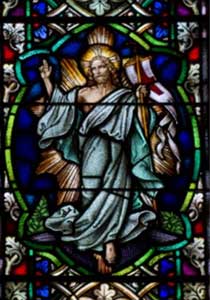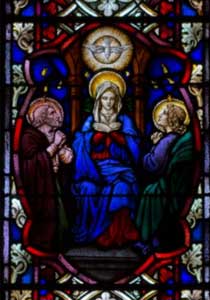PAGSAULOG SA PAGLINIS SA PANUMDOMAN UG PAGTUGYAN SA SIMBAHAN SA IKATULO NGA MILENYO NGADTO KANG MARIA
Elements of the celebration
1. The presence of the Crucifix
The presence of the Crucifix near the Sanctuary (the Processional Cross with Corpus will do) is meant to emphasize that the confession of sins and the begging of pardon are addressed to God, who alone can forgive sins.
2. The initial "statio"
At the beginning of the celebration there is a "statio" before the statue of the Pietà at Pilgrimage Site (in the Cathedral): the Church, like Mary, wishes to embrace the crucified Savior, to take responsibility for the past of her children and to implore the Father's forgiveness
At the same time the Church entrusts to Mary's protection her continuing journey in the New Millennium.
In other Churches the initial "statio" may be made at any statue of the Virgin near the entrance of the Church.
3. The Litany of the Saints
The "statio" is followed by a penitential procession towards the altar, The Jubilee Cross is accompanied by seven candles or lamps (unlit) and the Gospel Book, and the litany is sung. The image of the Birhen sa Cotta is carried by some ministers.
The Saints of the Communio Sanctorum intercede for their sinful brothers and sisters still on their pilgrim way towards the heavenly Jerusalem.
4. The confession of sins and the request for pardon
Following the homily and before the profession of faith comes the Prayer of the Faithful, in which the Celebrant makes the act of confession of sins and the request for pardon.
The prayer opens with an introduction followed by an invitatory and a prayer preceded by a brief moment of silence and the chanting of a triple, if possible, "Ginuo Kaloy-i Kami".
The invitatory is recited by representatives of the people, while the Celebrant recites the prayer.
During the chanting of the "Ginuo Kaloy-i Kami" the candles or lamps in front of the Crucifix are lit.
After the concluding prayer the Celebrant embraces and kisses the Crucifix as a sign of veneration and the imploring of pardon.
5. Commitment for a conversion of life and Entrustment of the Millennium to Mary's Protection.
At the end of the celebration, following the solemn blessing, the Celebrant asks that the purification of memory and the request for forgiveness be translated into a commitment of renewed fidelity to the Gospel on the part of the Local Church and of each of her members.
The Act of Entrustment is then recited by all.
The Celebration ends with the mass singing of the Jubilee Hymn.
HAN-AY SA PAGSAULOG SA PAGLINIS SA PANUMDOMAN UG PAGTUGYAN SA SIMBAHAN SA IKATULO NGA MILENYO NGADTO KANG MARIA
Sa may pultahan andamon ang Krus sa Jubileo nga yayongan og mga tawo, pito ka mga kandela nga bibtibiton og mga tawo, ang Basahon sa Ebanghelyo nga dad-on sa usa ka ministro, ug ang Andas sa Mahal nga Birhen nga yayongan usab og mga tawo.
Magtigom ang mga ministro alirong sa usa ka estatua sa Mahal nga Birhen diin himuon sa Nag-unang Alagad (Pari o Obispo) ang rituwal nga pagsugod ug paghimamat.
Human niini mupadayon pagsulti ang selebrante:
Mga igsuon, ang Simbahan dili makalabang sa tikanganan sa bag-ong milenyo sa walay pagdasig sa iyang mga anak paglinis sa ilang kaugalingon pinaagi sa pagbasol sa nangaging kasaypanan ug kahigayonan sa pagkadilimasinundanon, sa dili pagkamatinud-anon ug sa pagkahinay mulihok (TMA, 33).
Ug mao nga sa atong kasaulogan karon mangayo kita og pasaylo gkan sa Dios sa mga sala nga nahimo sa mga kristiyanos sa pagpanglabaysa mga gatosan nga katuigan.
Kini nagbukas usab alang kanato og bag-ong pagtahan atubangan sa Dios ug atubangan sa katawhan sa atong pagpadayon sa atong pagpanaw sa pag-usab sa atong mga binuhatan ug sa atong mga panglantaw.
Niining unang tuig sa bag-o nga milenyo, sa tibuok natong kusog, galamhan, kasingkasing ug kabubut-on, uban sa panalangin sa Dios ug sa pangaliyupo sa atong Inahan, ang Birhen Maria, mutahan kita pag-usab pagpuyo ug pagkinabuhi sa atong pagtuo.
Kining pagtahan atong itugyan ngadto sa Putli nga Kasingkasing ni Maria
Ug busa magsugod na usab kita pag-usab sa atong panaw sa ngalan sa Ginuo. Amen.
Dinhi awiton ang Litaniya sa mga Santos ug mupaingon sa Santuaryo ang tanan. Mag-una ang mga siriales. Musunod ang magdala sa Krus sa Jubileo, ang magdala sa Basahon sa Ebanghelyo, ug ang magyayong sa Andas sa Mahal nga Birhen, ug ang mga nagbitbit sa pito ka mga kandela (wala pa madagkoti) nga ipahamutang nila duol sa Krusipiho.
Musunod ang ubang mga Kolitos ug mga ministro.
Sa kataposan ang Celebrante nga, human mapahamutang ang tanan, muinsenso sa altar sumala sa naandan.
Pagkahuman, awiton ang "Himaya sa Dios didto sa langit" ug ang mga pag-ampo ug mga pagabasahon sumala sa naandan.
Human sa Ebanghelyo basahon o ipabasa kining musunod .
"Nagtindog ako sa pultahan ug nagtuktok" (Gipadayag 3,20)
Binati namo nga kaigsuonan,
Ang kinabuhi nga kristohanon panaw isip Simbahan.
Sa dili pa kita mupadayon sa atong panaw niining Ikatulo nga Milenyo, maghimo usa kita'g usa ka butang.
Mulingi kita.
Sa atong pagbaktas sa dalan taliwala sa mga kahingawaan sa Kasaysayan sa Tawo, mitumaw usahay ang mga paagi nga wala mahitukma sa Ebanghelyo.
Ug busa sa atong pagsugod og lain nga Milenyo, kinahanglan nga maghimo kita'g pag-usisa sa tanlag: hain na man kita dad-a ni Cristo, diin mang dapita misimang kita sa atong kadugtongan sa katawhan.
Ang Simbahan mag-usisa sa mga ngitngit nga dapit sa iyang kasaysayan ug maghukom niini pinasikad sa Ebanghelyo.
Ang Simbahan labaw unta nga makaamgo unta nga ang mga faithful namatud-an nga mga unfaithful sa paglabay sa mga gatosan ka katuigan ug nakasala batok kang Cristo ug sa Ebanghelyo.
Ang Simbahan mag-ila unta ug nagasugid sa mga kakulangon sa iyang kasakopan, ug mag-amgo nga ang ilang mga sala ingon sa daghang mga pagbudhi ug pagbabag sa mga mamahimo untang makab-ot sa laraw sa Manunubos.
Dili siya makatikang sa labanganan sa bag-o nga Milenyo sa walay pagdasig sa iyang mga anak sa paglinis sa ilang kaugalingon, pinaagi sa pagbasol, gikan sa nangagi nga mga kasaypanan, pagkadili matinud-anon ug pagkamasimangon.
Ang pag-angkon sa pagkahuyang sa nangaging panahon usa ka buhat sa pagkamatinud-anon ug pagkamakusganon nga magtabang kanato pagpahimsog sa atong pagtuo, ug mag-andam kanato pag-atubang sa mga hagit niini (TMA, 33).
Bisan og personal wala silay mga tulubagon, wala kini magpasabot nga ang ilang binuhatan nga dili nato matugotan karon, dili sayop sa ilang panahon.
Ug ang pag-amgo sa kahimtang sa ilang panahon nga nagluwas kanila sa ilang tulubagon wala magpasabot nga ang Simbahan dili magbasol niini. Kinahanglan nga pasayluon kita labaw pa sa magpasaylo kita.
Sa atong pagtahan pag-usab pagkinabuhi sa Ebanghelyo sa sunod nga Usa Ka Libo ka Katuigan, mangayo kita'g pasaylo sa Dios sa mga panahon nga misimang kita sa Ebanghelyo.
Ug busa, ang Simbahan nagabati "sa katungdanan sa pagpadayag og tumang pagbasol sa kakahuyangan sa daghan niyang mga anak nga nagbuling sa iyang nawong, nga nagbabag kaniya paghulagway sa hingpit sa iyang gilansang sa Krus nga Ginuo, mahigugmaon ug malumo" (TMA 35).
Ug mao nga karong adlawa, kami, ang inyong mga magbalantay, nagsangpit kang Maria, Tigpanalipod sa mga Makasasala, pagtabang kanamo pagpangyo og pasaylo.
Sa kabahin natong tanan, nangayo kami og pasaylo nga ato lamang gipasagdan, gitugotan, ug niapil pa gani kita sa mga buhat sa karon ginganlan na sa atong katilingban oggraft and corruption, nga mao ang tinobdan sa tanan natong mga kagul-anan.
Sa kabahin namo, ang inyong mga Magbalantay, mibati kami nga kami mismo mangayo og pasaylo sa Dios ug sa katawhan nga among nasamdan.
Sa among paghimo niini among gihandom ang gitudlo sa Ginuo (Mateo 5,23-24): "inigdala na nimo sa imong halad sa Dios ngadto sa halaran ug didto mahinumdoman mo nga nasilo kanimo ang imong isigkatawo, biyai ang imong halad atubangan sa halaran, ug adtoa dayon ang imong isigkatawo, ug pakig-uli una kaniya."
Kinsa man ang Igsuon nga kinahanglan among pakighiulian ug pangayoan og pasaylo?
- •Ang among mga magtatabang sa among pangalagad, ang among igsuong mga pari ug mga relihiyuso nga may katungod nga among matngonan ug hatagan ug soporta aron malipay sila.
- •Ang mga hiniplig nga katawhan: ang mga walay pangita, ang gagmayg mga suhol, ang mga binatonan, mga angol, mga batang nagtrabaho, mga gagmayng mga kriminal, mga tawo nga nakalimtan sa katilingban, nga nagpaabot gikan kanamo nga among makit-an diha kanila ang nawong ni Cristo.
- •Ang mga lumad nga makadaghan namo wala hisabti o wala panumbalinga, nga wala namo atimana o kang kinsa wala kami makasulti mahitungod sa Dios nga amo man unta kining katungdanan; nga among gipakabaliwala o gani gibiaybiay, nga sa paglabay sa gatosan nga katuigan nahimong mga biktima sa inhustisya sa bag-ong mga nangabot nga sa ilang pagkabuta nakamenos kaayo sa ilang mga paagi ug kultura.
- •Ang among mga igsuon nga mga Muslim, nga bisan og nagsimba kita sa mao ra nga Dios, sa pagkahimo niining kapupud-an nga usa ka nasod nahimong mga tawo nga wala saligi, wala panumbalinga, o wala masabti ug gisalikway, uban kanila buot unta kaming musud-ong sa nawong sa Dios sa Kaluoy.
- •Ang mga walay yuta nga nagpaabot unta gikan kanamo og pagpanguna sa paghimo nga makaambit sila sa yuta nga gitagana kanila sa Magbubuhat.
- •Ang among mga igsuon sa Iglesia Filipinista nga natawo dinha sa mga pakigbisog sa usa ka nasod nga nakiggubat alang sa kaugalingnan.
- •Ang tanan nga mubati nga gilabyan lang sila niining mga grupoha ug nga adunay makaturanganon nga kasilo kanamo isip mga magbalantay sa Simbahan.
Human sa Dios, kaninyong tanan, mga igsuon, amo nga gipadangat kaninyo kining mapaubsanon namong hangyo sa inyong pasaylo.
Sa samang higayon amo usab nga ibungat ang among pagpasaylo niadtong tanan nga nakasamad kanamo.
Ug kadtong mga sakop sa atong pundok nga nasamdan usab ug nasakitan og maayo, amo silang gihangyo sa pagbaton ug kusog sa pagpasaylo niining Tuig sa Dinagkong mga Pagpasaylo.
Sa among paghimo niining hiniusa natong paglinis sa panumdoman, nagadayeg usab kami sa Dios, ang Amahan, tungod sa mga buhat sa atong katigulangan diha sa Pagtuo nga naghimo nga maanyag ang atong Simbahan.
- •Among hisgotan ang mga misyonero nga taliwala sa dagkong kalisdanan mipugas ug mipalambo sa mga mithi ug mga buhat sa pagtuo sa atong katigulangan nga sa Jubileo ato unta nga balikan.
- •Among hisgotan ang mga babaye nga naningkamot nga ang ilang mga anak mutubo dinha nianang maong pagtuo ug ang uban gani kanila nimugna og mga Pundok sa Kamadrehan.
- •Among hisgotan labaw sa tanan ang garbo sa atong Pagtuo: ang mga nanag-antos alang niini, ug ang uban niini gipatay sama nila ni San Lorenzo Ruiz ug Beato Pedro Calungsod.
Karon, tungatunga sa atong pagsaulog sa Dakong Jubileo sa Tuig nga nagsugod sa Bag-ong Milenyo maminaw kita sa Ginuo nga nagdapit (Gipadayag 3,20): "Nagtindog ako ug nagtuktok; kon may makadungog sa akong tingog ug moabli sa pultahan, mosulod ako sa iyang balay ug makigsalo kaniya, ug mokaon ako uban kaniya."
Atong padayunón ang Ginuo.aron ato usab nga masinati ang Dios nga gipaila niya nga atong Abba kon "Tatay". Sa samang higayon madawat nato ang Balaan nga Espiritu nga gipadala ni Jesús aron pagbûbô sa "iyang gugma sulod sa atong mga kasingkasing (Roma 5,5)".
Gitudloan kita og mga paagi sa pagpadayún sa Ginuo.
Usa niini mao ang makanunayon nga pagdangop, pasangpit, ug pagpakig-uban kang Maria.Tahas ni Maria ang pagdalá kanato kang Jesús (Juan 2,5): "Buhata ninyo bisan unsay iyang isugo kaninyo."
Gikinahanglan kaayo ang pagdangop kang Maria kay niining atong panahon karon nagkadinagko ang pag-asdang sa mga kaaway ni Cristo, sa mga kaaway sa Simbahan.
Dili kini nato ikatingala kay daan na kining gitagna. Ang Basahon sa Gipadayag naghisgot og dakong bugno. Tinuod mga simbolo lamang kini, apan masabtan nato nga ang "babaye nga nanganak ug batang lalaki" mao si Maria (Gipadayag 5,5).
Niining dakong espirituhanon nga bugnò magpaapil kita sa pundok ni Maria nga magdala kanato sa Kadaugan.
Sa atong pagpanaw ngadto sa unahan sa ikatulo nga milenyo, sa tibuok natong kusog, kasingkasing ug kabubut-on, motahan kita pag-usab pagbukas sa mga pultahan ug pagpadayún sa atong kapupod-an sa Ginuong Jesús uban sa panabang ug panalipod ni Maria, atong Inahan.
Alang niini ug nunot sa diwa sa Tertio Millenio Adveniente atong han-ayon pag-ayo ang mga himuunon isip Simbahan pinasikad sa Konsilyo Batikano Dos ug sa Ikaduha nga Konsilyo Plenaryo sa Pilipinas.
Aron gayod molambo ang atong Simbahan kinahanglan kini ato nga ibutang sa maayong pagkahan-ay sama sa gihisgotan ni San Pablo (Corinto 12,28): "Diha sa iglesia gipahimutang sa Dios ang tanan sa husto nga dapit."
Ug kining tanan atong itugyan ngadto sa panalipod ni Maria, Inahan sa Dios ug atong Inahan. Ato kining itugyan ngadto sa iyang Mahigumaon ug Putli nga Kasingkasing.
Ug mupadayon kita sa atong panaw nga nakabaton og kusog sa atong pag-ila sa atong pagkasamdan ug sa mga panig-ingnan sa mga maayong tawo nga miuna kanato.
Uban kang Maria nga magtultol kanato, kami, ang inyong mga Magbalantay, nagaampo nga diha ni Cristo ug pinaagi sa Espiritu Santo, kita usab makapauli sa kinaugalingon ug sa hiniusang paagi ngadto sa balay sa Amahan niining Tuig sa Dakong Jubileo, ug makabaton ug kaisog pagtultol kaninyo sa dalan.
Kaninyo mabination,
Inyong Obispo ug Kaparian.
Isunod ang Pag-ampo sa Katilingban diin bungaton ang tinagsa nga pagpangayo og pasaylo. Kini sa dili pa ang pagbungat sa Pagsugid sa Pagtuo kon Credo.
PAG-AMPO SA KATILINGBAN
Selebrante:
Kaigsuonan, mulingi kita ngadto sa Dios atong Amahan, maluluy-on ug mabination, dugay nga masuko, mahigugmaon ug matinud-anon kaayo, ug pangayuon nato kaniya pagdawat sa pagbasol sa iyang katawhan nga mapaubsanon nga nagsugid sa ilang kasal-anan, ug pagpadangat kanila og kaluoy.
Ang tanan mag-ampo dinha sa kahilom.
I. LINANGKOB NGA PAGSUGID SA KASAL-ANAN
Magbabasa:
Mag-ampo kita nga ang atong pagsugid sa mga sala ug ang atong pagbasol gidasig sa Espirit Santo, nga ang atong pagbasol ginaamgo, lawom, ug nga mapaubsanong nagtan-aw sa kasal-anan nga nangagi dinha sa usa ka matinud-anon nga "paglinis sa panumdoman", mutahan kita sa pagsunod sa dalan sa tinuod nga pagkakabig.
Hilom nga Pag-ampo.
Selebrante:
Ginuong Dios, kining imong nagapanaw nga Simbahan, nga kanunay nimong gibalaan sa dugo sa imong Anak, sa matag kaliwatan adunay mga anak kansang pagkabalaan nagasidlak pag-ayo ug kansang pagsukol nagbatok sa Pagtuo nga among gisugid ug sa Ebanghelyo.
Ikaw nga nagpabilin nga kanunay nga matinud-anon dinha sa among pagkadilimatinud-anon, pasayloa ang among mga sala, ug himoa nga magsaksi kami og tinuod kanimo atubangan sa tanang katawhan.
Kini among gipangayo pinaagi ni Cristo among Ginuo.
R. Amen.
Mag-aawit: Ginuo, maluoy ka; Ginuo, maluoy ka; Ginuo, maluoy ka.
Katawhan:
Ginuo, maluoy ka; Ginuo, maluoy ka; Ginuo, maluoy ka.
Usa ka kandela o suga atubangan sa Krusipiho dagkotan.
II. PAGSUGID SA MGA SALA NGA NAHIMO SA PAGPAHIGAYON SA KAMATUORAN
Magbabasa:
Mag-ampo kita nga ang matag usa kanato, nga nagtan-aw sa Ginuong Jesus, malumo ug mapaubsanon og kasingkasing, muangkon nga bisan ang mga Nanag-alagad sa Simbahan, sa ngalan sa pagtuo ug maayong pamuhatbuhat, usahay migamit og mga paagi nga supak sa Ebanghelyo diha sa solemne nila nga pagpanalipod sa kamatuoran.
Hilom nga Pag-ampo.
Selebrante:
Ginuong Dios sa tanang katawhan, sa pipila ka yugto sa kasaysayan, ang mga kristiyanos usahay misangpot sa walay pagpatugot sa binuhatan sa uban ug wala magmatinud-anon sa sugo sa gugma ug sa ingon mipahugaw sa nawong sa Simbahan, ang imong Esposa.
Kaluy-i ang imong makasasala nga mga anak ug dawata ang among among pagsaad pagpangita ug pagpalambo sa kamatuoran diha sa kalumo sa gugma uban sa hugot nga kaamgohan nga ang kamatuoran muhari lamang pinaagi sa kusog sa mismong kamatuoran.
Kini among gipangayo pinaagi ni Cristo among Ginuo.
R. Amen.
Mag-aawit: Ginuo, maluoy ka; Ginuo, maluoy ka; Ginuo, maluoy ka.
Katawhan:
Ginuo, maluoy ka; Ginuo, maluoy ka; Ginuo, maluoy ka.
Usa ka kandela o suga atubangan sa Krusipiho dagkotan.
III. PAGSUGID SA KASAL-ANAN NGA NAKASAMAD SA KAHIUSAHAN SA LAWAS NI CRISTO
Magbabasa:
Mag-ampo kita nga ang atong pag-angkon sa mga sala nga nakagisi sa kahiusahan sa Lawas ni Cristo ug nakasamad sa inigsuon nga panaghigugmaay makapasayon sa dalan sa panaghiuli ug sa panag-ambitay sa mga kristiyanos.
Hilom nga Pag-ampo.
Selebrante:
Maluluy-on nga Dios, sa gabii sa wala pa siya magpasakit, ang imong Anak miampo alang sa kahiusahan niadtong mutuo kaniya; apan sa wala pagtuman sa iyang kabubut-on, ang mga matuuhon nagbatokay, nagkabulag ug nagsalikwayay nagkaawayay batok sa usa'g usa.
Nag-ampo kami'g tinuod ug nangaliyupo sa imong pasaylo ug nangayo sa gasa sa mabasulon nga kasingkasing, aron, isip mga kristiyanos, nga nagkahiuli kanimo ug sa usa'g usa, makasinati kami pag-usab, diha sa usa ka lawas ug usa ka espiritu, sa kalipay sa hingpit nga kahiusahan.
Kini among gipangayo pinaagi ni Cristo among Ginuo.
R. Amen.
Mag-aawit: Ginuo, maluoy ka; Ginuo, maluoy ka; Ginuo, maluoy ka.
Katawhan:
Ginuo, maluoy ka; Ginuo, maluoy ka; Ginuo, maluoy ka.
Usa ka kandela o suga atubangan sa Krusipiho dagkotan.
IV. PAGSUGID SA MGA SALA BATOK SA KATAWHAN SA ISRAEL
Magbabasa:
Mag-ampo kita nga sa paghandom sa mga kasakit nga giantos sa katawhan sa Israel dinha sa kasaysayan, ang mga kristiyanos muangkon sa mga sala nga nahimo sa dili diyutay sa ilang gidaghanon batok sa katawhan sa Kasabotan ug sa mga panalangin, ug niining paagiha maglinis sa ilang kasingkasing.
Hilom nga Pag-ampo.
Selebrante:
Dios sa among katigulangan, imong gipili si Abraham ug ang iyang kaliwatan pagdala sa imong ngalan ngadto sa Kanasoran: nahasubô kami pag-ayo sa binuhatan niadtong nakapaantos niining imong mga anak sa paghikyad sa kasaysayan, ug diha sa among pagpangayo sa imong pasaylo buot kami mutahan sa among kaugalingon sa matuod nga panag-inigsuonay sa Katawhan sa Kasabotan.
Kini among gipangayo pinaagi ni Cristo, among Ginuo.
R. Amen.
Mag-aawit: Ginuo, maluoy ka; Ginuo, maluoy ka; Ginuo, maluoy ka.
Katawhan:
Ginuo, maluoy ka; Ginuo, maluoy ka; Ginuo, maluoy ka.
Usa ka kandela o suga atubangan sa Krusipiho dagkotan.
V. PAGSUGID SA MGA SALA NGA NAHIMO BATOK SA GUGMA, KALINAW, MGA KATUNGOD SA KATAWHAN, UG PAGTAHOD SA MGA KULTURA UG MGA RELIHIYON
Magbabasa:
Mag-ampo kita nga diha sa pagtan-aw kang Jesus, atong Ginuo ug atong Kalinaw, ang mga kristiyanos magbasol sa mga pulong ug panglantaw nga gipahigayon sa pagpataas, pagdumot, pagpangandoy sa pagharihari sa uban, pagbatok sa kasakopan sa uban nga mga relihiyon ug sa kinakahuyang nga mga pundok sa katilingban, ingon sa mga nanglangyaw ug mga nanimpalad.
Hilom nga Pag-ampo.
Selebrante:
Ginuo sa kalibotan, Amahan sa tanan, pinaagi sa imong Anak nihangyo ka kanamo paghigugma sa among mga kaaway, paghimo og kaayohan ngadto sa mga nagdumot kanamo ug pag-ampo alang niadtong mga naglutos kanamo.
Apan ang mga kristiyanos sa makadaghan milimod sa Ebanghelyo; sinunod ang panglantaw sa gahom, ilang giyatakan ang mga katungod sa mga pundok nga lumadnon ug uban pang katawhan nga susama niini, ug ilang gipakita ang ilang pagsalikway sa mga kultura ug mga tradisyon sa relihiyon: pagmainantuson ug pagmaluluy-on kanamo, ug hatagi kami sa imong pasaylo!
Kini among gipangayo pinaagi ni Cristo, among Ginuo.
R. Amen.
Mag-aawit: Ginuo, maluoy ka; Ginuo, maluoy ka; Ginuo, maluoy ka.
Katawhan:
Ginuo, maluoy ka; Ginuo, maluoy ka; Ginuo, maluoy ka.
Usa ka kandela o suga atubangan sa Krusipiho dagkotan.
VI. PAGSUGID SA MGA SALA BATOK SA KAHALANGDON SA KABABAYEN-AN UG SA KAHIUSAHAN SA KALIWATAN SA TAWO
Magbabasa:
Mag-ampo kita alang sa tanan niadtong nag-antos sa mga pagbatok sa ilang tawhanon nga kahalangdon ug kansang mga katungod giyatakan; mag-ampo kita alang sa kababayen-an, nga masubsob gipaubos ug gipadaplin, atong angkunon ang mga higayon sa mga pagtugot niining matanga sa mga sala nga nahimo usab sa mga kristiyanos.
Hilom nga Pag-ampo.
Selebrante:
Ginuong Dios, among Amahan, imong gimugna ang tawo, lalaki ug babaye, sa imong larawan ug kasamahan ug mibuot ikaw sa kalahian sa katawhan sulod sa kahiusahan sa Banay sa Tawo. Apan matag karon ug unya, ang pagkamanagsama ra sa imong mga anak wala ilha, ug ang mga kristiyanos nakasala pinaagi sa mga panglantaw sa pagsalikway ug sa pagpagawas, diha sa pagtugot sa mga buhat sa paghiplig tungod sa matang sa panit ug pinulongan sa tawo.
Pasayloa kami ug ipadangat ang grasya sa pag-alim sa mga samad nga anaa pa gihapon dinhi sa imong katilingban tungod sa sala, aron kaming tanan mubati nga imo kaming mga anak.
Kini among gipangayo pinaagi ni Cristo, among Ginuo.
R. Amen.
Mag-aawit: Ginuo, maluoy ka; Ginuo, maluoy ka; Ginuo, maluoy ka.
Katawhan:
Ginuo, maluoy ka; Ginuo, maluoy ka; Ginuo, maluoy ka.
Usa ka kandela o suga atubangan sa Krusipiho dagkotan.
VII. PAGSUGID SA MGA SALA TALI SA MGA BATAKAN NGA KATUNGOD SA TAWO
Magbabasa:
Mag-ampo kita alang sa tanang katawhan sa kalibotan, lalaki ug babaye, ilabi na sa mga bata pa nga mga nangaangin sa mga pag-abuso, alang sa mga kabos, sa mga napahiplig, sa mga gipahimoslan; mag-ampo kita alang niadtong labing dili makapanalipod sa ilang kaugalingon, ang mga wala pa mangatawo nga gipangpatay sa sabakan sa ilang mga inahan, o gigamit alang sa mga pag-eksperimento niadtong mga nag-abuso sa kahimanan sa teknolohiya mahitungod sa kinabuhi ug naghiwi sa mga tumong sa siyensiya.
Hilom nga Pag-ampo.
Selebrante:
Dios, among Amahan, kanunay ikaw naminaw sa singgit sa mga kabos. Makapila wala makaila ang mga kristiyanos mismo kanimo dinha sa mga gigutom, mga giuhaw, mga walay sapot, mga gilutos, mga gibilanggo, ug dinha sa mga dili makapanalipod sa ilang kaugalingon ilabi na sa unang mga yugto sa kinabuhi.
Tungod niadtong tanan nga nakahimo og mga buhat sa inhustisya pinaagi sa pagsalig sa bahandi ug gahom, ug nagpakita'g pagtamay sa "mga gagmay" nga imong gimahal pag-ayo, nangayo kami og pasaylo: kaloy-i kami ug dawata ang among pagbasol ug paghinulsol.
Kini among gipangayo pinaagi ni Cristo, among Ginuo.
R. Amen.
Mag-aawit: Ginuo, maluoy ka; Ginuo, maluoy ka; Ginuo, maluoy ka.
Katawhan:
Ginuo, maluoy ka; Ginuo, maluoy ka; Ginuo, maluoy ka.
Usa ka kandela o suga atubangan sa Krusipiho dagkotan.
Panapos nga Pag-ampo
Selebrante:
Labing maluluy-on nga Amahan, ang imong Anak, si JesuCristo, ang maghuhukom sa mga buhi ug sa mga patay, diha sa pagpaubos sa iyang unang pag-anhi miluwas sa katawhan gikan sa sala ug diha sa iyang mahimayaon nga pagbalik mangayo og husay sa matag sala.
Itugot nga ang among katigulangan, ang among kaigsuonan, mga lalaki ug mga babaye, ug kami, ang imong mga alagad, nga pinaagi sa grasya sa Espiritu Santo, nagabalik nganha kanimo sa tumang pagbasol, mubati sa imong kaluoy ug makadawat sa imong pasaylo.
Kini among gipangayo pinaagi ni Cristo, among Ginuo.
Tanan: Amen.Human sa Panapos nga Pag-ampo, ang Selebrante mugakos ug muhalok sa Krusipiho isip timaan sa pagsimba niini ug pagpangaliyupo sa pasaylo.
Mupadayon ang Misa gikan sa Pagbungat sa Pagsugid sa Pagtuo kon Credo.
Pagkatapos sa kasaulogan, sunod sa solemne nga panalangin, ang selebrante mutahas sa katawhan paghobad sa paglinis sa panumdoman ug pagpangayo og pasaylo ngadto sa pagtahan sa binag-o nga pagkamatinud-anon sa Ebanghelyo sa kabahin sa Lokal nga Simbahan ug sa matag sakop niini, ginamit kining musunod o susama nga mga pulong:
Mga igsuon, tapos na kita makaampo nga linisan ang atong panumdoman sa mga buling sa atong kasal-anan ug sa kasal-anan sa kasakopan sa atong Simbahan nga nagdala sa ngalan nga kristiyanos.
Nangayo kita og pasaylo sa Dios alang sa atong Simbahanong Panimalay kon Diosesis sa mga kasaypanan sa atong katigulangan ug sa atong kaugalingon nga kasal-anan.
Ato kining hubaron diha sa atong binag-o nga pagtahan sa pagkinabuhi sumala sa Ebanghelyo.
Sa atong pagpanaw ngadto sa unahan sa ikatulo milenyo, sa tibuok natong kusog, kasingkasing ug kabubut-on, motahan kita pag-usab pagbukas sa mga pultahan ug pagpadayún sa atong kapupod-an sa Ginuong Jesús uban sa panabang ug panalipod ni Maria, atong Inahan.
Ug kini atong itugyan ngadto sa panalipod ni Maria, Inahan sa Dios ug atong Inahan. Ato kining itugyan ngadto sa iyang Mahigumaon ug Putli nga Kasingkasing.
Isunod ang paglitok sa tanan sa Akto sa Pagtugyan:
"O Inahan sa tanang katawhan, ikaw nga nasayud sa among mga kasakit ug mga gilauman, ikaw nga may inahanong pag-alinggat sa tanang panlimbasog tali sa maayo ug sa dautan, tali sa kahayag ug sa kangitngit, nga nagsamok sa among nasud, patalinghugi ang pagtuwaw namo, dinsaig sa Espiritu Santo, nga among gitumong ngadto sa imong Kasingkasing.
"Diha sa gugma sa inahan ug sa Suluguon sa Ginuo, gaksa ang katawhan niining among kalibotan karon, nga among gitugyan ug gihalad kanimo, kay nabalaka kami sa kasamtangan ug sa walay kataposang pagadangatan sa among nasud ug sa iyang katawhan.
"Tan-awa kami dinhi sa among pagluhod sa imong atubangan, O Inahan ni Cristo, atubangan sa imong Putli Uyamot nga Kasingkasing, buot kami, uban sa tibuok Simbahan, pagdugtong sa among kaugalingon ngadto sa pagtugyan nga tungod sa iyang gugma kanamo gihimo sa imong Anak ngadto sa Amahan sa iyang pag-ingon: 'Ug tungod kanila gitugyan ko ang akong kaugalingon nganha kahimo aron maimo usab sila' (Jn 17,19).
"Buot kaming mahiusa sa among Manunubos niining maong pagtugyan alang sa kalibotan ug alang sa katawhan, pagtugyan nga, diha sa iyang diosnon nga kasingkasing, adunay gahom pagpadangat og pasaylo ug pagbayad sa among kasal-anan.
"Labaw sa tanang mga binuhat, dayegon ikaw, O Suluguon sa Ginuo, nga sa kinahingpit nga paagi mituo ug misunod sa pagtawag sa Dios!
"Maghimaya ka, ikaw nga tumang nahiusa sa makaluwas nga pagtugyan sa imong Anak!
"Inahan sa Simbahan, lamdagi ang katawhan sa Dios sa mga dalan sa pagtuo, paglaum ug paghigugma!
"Niining among pagtugyan sa among kaugalingon nganha kanimo, O Inahan, amo usab nga gitugyan kini mismong pagtugyan, nga among gipahamutang sa imong inahanon nga kasingkasing.
"O putli uyamot nga Kasingkasing! tabangi kamo pagbuntog sa mga hulga sa dautan, nga sayun na kaayong nakagamot diha sa mga kasingkasing sa katawhan karon, ug kansang dili masukod nga mga sangputanan nakapaunlod sa sa among kalibotan sa among panahon karon ug daw nagbabag sa mga dalan padulong sa among ugma!
"Sa kagutom ug gubat, luwasa kami.
"Sa pagpinatyanay pinaagi sa mga bomba nga nuklear, sa dili masukod nga paglaglag sa kaugalingon dinha sa tanang matang sa gubat, luwasa kami.
"Sa mga sala batok sa kinabuhi sa tawo gikan sa sinugdanan mismo niini, luwasa kami.
"Sa mga pagdumot ug mga pagyatak sa kahalangdon sa mga anak sa Dios, luwasa kami.
"Sa tanang matang sa inhustisya diha sa kinabuhi sa among katilingban, nasudnon ug dinha sa kalibotan, luwasa kami.
"Sa sayon lamang nga pagyatak sa mga sugo sa Dios, luwasa kami.
"Sa mga pagsulay pagsumpo sa mismong kamatuoran sa Dios dinha sa mga kasingkasing sa tawo, luwasa kami.
"Sa pagkahanaw sa pag-alinggat sa maayo ug sa dautan, luwasa kami.
"Sa mga sala batok sa Espiritu Santo, luwasa kami, luwasa kami.
"Dawata, O Inahan ni Cristo, kining pagtuwaw nga gibug-atan sa mga pag-antos sa tanang katawhan ilabi na namong mga pilipino.
"Tabangi kami sa gahom sa Balaan nga Espiritu sa pagbuntog sa tanang sala ug sa "sala sa kalibotan", sa sala dinha sa tanan nga dagway niini.
"Sa makausa pa, ipadayag dinhi sa kasaysayan sa kalibotan ug sa among nasod ang walay kinutoban ug makaluwas nga gahom sa Pagpanubos: ang Gahom sa mululuy-on nga gugma!
"Nga mahunong na ang daotan!
"Nga mabag-o na ang mga tanlag!
"Nga mapadayag sa imong Putli nga Kasingkasing ang kahayag sa Paglaum alang sa tanan! Amen.


